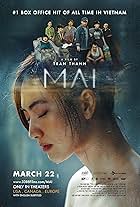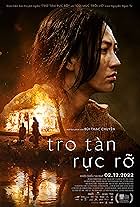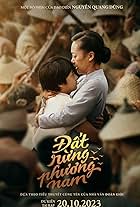In 1946 Hanoi battle, a Hanoian fighter hides at pho vendors' homes to retrieve arms from French soldiers, offering pho as a bargain for chives.In 1946 Hanoi battle, a Hanoian fighter hides at pho vendors' homes to retrieve arms from French soldiers, offering pho as a bargain for chives.In 1946 Hanoi battle, a Hanoian fighter hides at pho vendors' homes to retrieve arms from French soldiers, offering pho as a bargain for chives.
- Awards
- 1 nomination
Photos
Storyline
Did you know
- TriviaOfficial submission of Vietnam for the 'Best International Feature Film' category of the 97th Academy Awards in 2025.
Featured review
I. The setting and props: This is a stage that is not made with heart.
This is probably true for those who have spent their childhood watching stage drama programs on TV such as 'Gap nhau cuoi tuan', 'Ngay xua ngay xua' or the still existing 'Tao quân', then the visual feeling of 70% of the film is exactly like that.
The setting is like a stage scene, even the dramatic battlefield scenes also have a 'dramatic' feeling. Just looking at a few background details and props also reflects that the set-up team has very basic knowledge about war, even though state-owned film studios release revolutionary films every year.
An example that appears continuously is the walls of the houses in the battlefield scenes: There is not a single bullet hole or bomb fragment hole. The walls are only painted old, broken in a few places at the edges, revealing the bricks, but are very flat and intact. Drawing a few holes is fine but nope, almost nothing is visible.
Or the plastered walls of that time, although not as thick as the chalk of today's hot tiktoker girls, were still bulletproof and bombproof. Probably.
--------------------
II. Dialogue, acting and visuals - Poor and cheesy scriptwriting
The 'dramatic' element is also very clearly shown in this part.
The dialogue scenes with many characters are mostly frontal camera angles, the actors are arranged horizontally, turning their bodies to the camera instead of talking directly, as if we are the audience sitting in the auditorium watching a play. The most obvious are the scenes with the priest or the scenes showing the 'poetry, romance' when the male and female leads are private.
Of course, there are also zooms in and out, pans, foreground and background, etc... but they are only at the level of TV series, very few shots bring the cinematic feel of theatrical films.
The dialogue is too written, bookish, not spoken. Well, the romantic, poetic scenes, the enlightenment of truth can be accepted as a bit cheesy, but the fierce battlefield scenes, or the dialogue of ordinary people like shoe shiners, pho sellers, peasant soldiers... are also quite old-fashioned.
I know it's a movie about revolution, with propaganda and all that... But if you say it's to be shown in theaters to compete in the market, a screenwriter like this will quit.
Or at that time, people were highly educated, everyone was well-educated, all social classes, in every life-and-death situation, bombs and bullets flew. Probably.
And we can't talk about the climax scene that ended the 'epic' that you saw in the trailer: The tank explosion scene. Just one sentence to end it; CGI of an American instant noodle action movie, but in 2010.
--------------------
III. Content: Clumsy and with many unnecessary details.
A typical example of unnecessary details, sadly (laughingly) is shown right in the movie title. The movie is 'peach, pho and piano' but if there were no peach, pho and piano, it would not affect the content of the movie at all.
I understand the director's intention is to show the essence of Vietnam, Hanoi, art... bla bla... by metaphor. But it feels forced and doesn't fit the flow of the movie or the story at all.
Next, about the messy content, it's quite easy to see. Reviewing the events of the male lead is a typical example: Going to get things, going to get married, going to combat, going to a far away place, that's it. And we watch him running around in circles for 1 hour and 40 minutes.
If these events were well-constructed, it could create an 'epic' and it would still be good. But to be honest, none of the events are done well, even the part about being a blind hero in a deaf version is not very heroic.
The male lead, besides being reckless and daring to risk his life with the French, almost didn't do anything worthwhile. I don't even remember why he played so hard with the French. Well, I know it's like 'hatred of foreign invaders' but we have to give the audience something to strengthen their faith.
The female lead is similar but has fewer events. Especially, everything she takes is destroyed. She goes to get the piano, the piano breaks. She gets married, but her husband dies. She gets the three-pronged bomb, but it's time for her to be destroyed.
In general, the main character has nothing surprising. The strongest twist is the pho seller and the ax-wielding combat scene.
In the end, they all die, the main and supporting characters are the same. The general idea is to say that the French are very evil. But from the beginning, there wasn't much to feel connected to the character, so in the end, nothing lingers.
--------------------
Conclusion.
To be fair, compared to the revolutionary films that are made every year to be shown for one show and then stored away, this film is a step forward. Basically, it chooses a more open topic, more poetic and romantic, less dry... But that is the only bright spot.
Making a film without fear of criticism from the audience (because they don't dare), without fear of losing money because it's not their own money, the content is done according to censorship... then 'this is very good'. But to be frank, it is the best of the bad.
And this is only talking about the visual aspect, the scriptwriting aspect, the acting aspect, the dialogue aspect... and has not touched on the historical aspect or delved into the content.
It's long-winded, thank you for reading.
This is probably true for those who have spent their childhood watching stage drama programs on TV such as 'Gap nhau cuoi tuan', 'Ngay xua ngay xua' or the still existing 'Tao quân', then the visual feeling of 70% of the film is exactly like that.
The setting is like a stage scene, even the dramatic battlefield scenes also have a 'dramatic' feeling. Just looking at a few background details and props also reflects that the set-up team has very basic knowledge about war, even though state-owned film studios release revolutionary films every year.
An example that appears continuously is the walls of the houses in the battlefield scenes: There is not a single bullet hole or bomb fragment hole. The walls are only painted old, broken in a few places at the edges, revealing the bricks, but are very flat and intact. Drawing a few holes is fine but nope, almost nothing is visible.
Or the plastered walls of that time, although not as thick as the chalk of today's hot tiktoker girls, were still bulletproof and bombproof. Probably.
--------------------
II. Dialogue, acting and visuals - Poor and cheesy scriptwriting
The 'dramatic' element is also very clearly shown in this part.
The dialogue scenes with many characters are mostly frontal camera angles, the actors are arranged horizontally, turning their bodies to the camera instead of talking directly, as if we are the audience sitting in the auditorium watching a play. The most obvious are the scenes with the priest or the scenes showing the 'poetry, romance' when the male and female leads are private.
Of course, there are also zooms in and out, pans, foreground and background, etc... but they are only at the level of TV series, very few shots bring the cinematic feel of theatrical films.
The dialogue is too written, bookish, not spoken. Well, the romantic, poetic scenes, the enlightenment of truth can be accepted as a bit cheesy, but the fierce battlefield scenes, or the dialogue of ordinary people like shoe shiners, pho sellers, peasant soldiers... are also quite old-fashioned.
I know it's a movie about revolution, with propaganda and all that... But if you say it's to be shown in theaters to compete in the market, a screenwriter like this will quit.
Or at that time, people were highly educated, everyone was well-educated, all social classes, in every life-and-death situation, bombs and bullets flew. Probably.
And we can't talk about the climax scene that ended the 'epic' that you saw in the trailer: The tank explosion scene. Just one sentence to end it; CGI of an American instant noodle action movie, but in 2010.
--------------------
III. Content: Clumsy and with many unnecessary details.
A typical example of unnecessary details, sadly (laughingly) is shown right in the movie title. The movie is 'peach, pho and piano' but if there were no peach, pho and piano, it would not affect the content of the movie at all.
I understand the director's intention is to show the essence of Vietnam, Hanoi, art... bla bla... by metaphor. But it feels forced and doesn't fit the flow of the movie or the story at all.
Next, about the messy content, it's quite easy to see. Reviewing the events of the male lead is a typical example: Going to get things, going to get married, going to combat, going to a far away place, that's it. And we watch him running around in circles for 1 hour and 40 minutes.
If these events were well-constructed, it could create an 'epic' and it would still be good. But to be honest, none of the events are done well, even the part about being a blind hero in a deaf version is not very heroic.
The male lead, besides being reckless and daring to risk his life with the French, almost didn't do anything worthwhile. I don't even remember why he played so hard with the French. Well, I know it's like 'hatred of foreign invaders' but we have to give the audience something to strengthen their faith.
The female lead is similar but has fewer events. Especially, everything she takes is destroyed. She goes to get the piano, the piano breaks. She gets married, but her husband dies. She gets the three-pronged bomb, but it's time for her to be destroyed.
In general, the main character has nothing surprising. The strongest twist is the pho seller and the ax-wielding combat scene.
In the end, they all die, the main and supporting characters are the same. The general idea is to say that the French are very evil. But from the beginning, there wasn't much to feel connected to the character, so in the end, nothing lingers.
--------------------
Conclusion.
To be fair, compared to the revolutionary films that are made every year to be shown for one show and then stored away, this film is a step forward. Basically, it chooses a more open topic, more poetic and romantic, less dry... But that is the only bright spot.
Making a film without fear of criticism from the audience (because they don't dare), without fear of losing money because it's not their own money, the content is done according to censorship... then 'this is very good'. But to be frank, it is the best of the bad.
And this is only talking about the visual aspect, the scriptwriting aspect, the acting aspect, the dialogue aspect... and has not touched on the historical aspect or delved into the content.
It's long-winded, thank you for reading.
Details
- Release date
- Country of origin
- Official site
- Language
- Also known as
- Peach Blossom, Pho and Piano
- See more company credits at IMDbPro
Box office
- Budget
- ₫20,000,000,000 (estimated)
- Gross worldwide
- $670,785
- Runtime1 hour 40 minutes
- Color
Contribute to this page
Suggest an edit or add missing content













